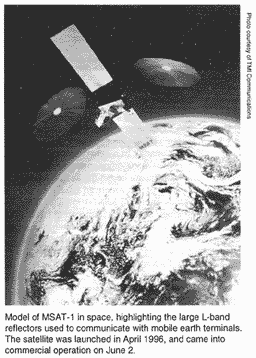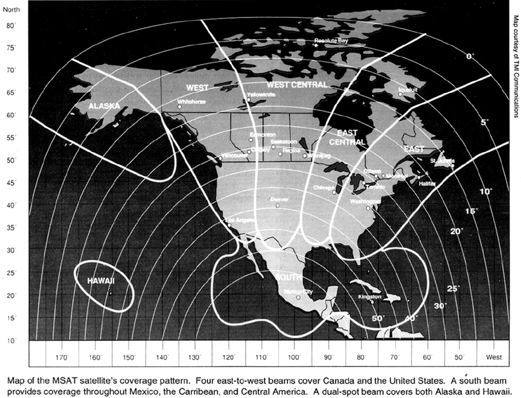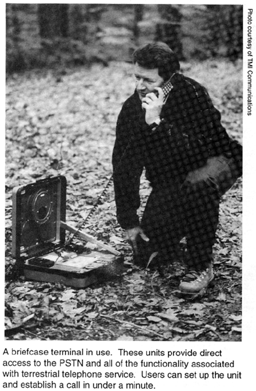
Satellite communications has longed played an important role in Canada's telecommunications infrastructure. Viewed by many Americans as the "Great White North," Canada is the second largest country in the world. While more than 90% of Canadians live within 200 miles of the U.S. border, the population outside of urban centers is distributed across a vast and geographically challenging territory in which telephone services are often difficult or impossible to provide through terrestrial means.
These characteristics created a strong incentive for the use of satellite communications. In 1969, the government of Canada, in partnership with major telephone companies, established Telesat Canada, the world's first domestic satellite communications system. Telesat's mandate was to bring essential telecommunications services to remote northern communities, augment the country's long-distance networks, and deliver Canadian television programming to more Canadians. The government also saw Telesat as a springboard to develop and export Canadian satellite expertise.
While Telesat operated geostationary satellites providing fixed satellite services (FSS) in the C- and Ku-bands (6/4 GHz and 14/12 GHz), the government began to envision a new generation satellite system that would operate with mobile terminals. As early as 1967, a NATO research program called Tacsatcom demonstrated the ability of satellites to communicate via mobile ground stations. Following more scientific research, in 1979, the World Administrative Radio Conference (WARC) allocated radio frequencies for mobile satellite systems, paving the way for commercial development, including the INMARSAT maritime system.
Concept and business feasibility studies conducted by the Canadian government and industry partners led, in 1988, to the creation of TMI Communications as a commercial mobile satellite company. Headquartered in Ottawa, TMI is part of the BCE Inc. group of companies that includes Bell Canada, BCE Mobile, and Nortel -- all noted leaders in the Canadian and international telecommunications business. The company was established just three years after the first cellular radio licenses were awarded in Canada, and the race was on to develop a satellite system and user equipment that would deliver the promise of cellular-like communications to users living far outside the range of terrestrial wireless systems.
MSAT-1 and AMSC-1 were designed and built under a formal Joint Capacity Agreement to assure network redundancy for customers of both systems. The satellites, therefore, have a virtually identical and extremely broad coverage area. Using a combination of six spot beams, MSAT-1 spans the North American free trade zone and the offshore economic zones of both countries, taking in Canada and its coastal waters, the continental United States, Mexico, the Caribbean region, and Central America. A specialized dual-spot beam covers Alaska and Hawaii (see accompanying map).
The satellite's geostationary orbit and the broad coverage area are, however, the only characteristics that MSAT-1 has in common with traditional FSS satellites. FSS satellites are designed primarily for high-speed transmission of analog and/or digital video, data, and voice communications, typically in private corporate networks and, other than consumer services such as direct-to-home broadcasting, the cost of satellite transmission and earth station equipment is largely unaffordable to individual users. In addition, earth station equipment must be mounted in a fixed orientation to the satellite, and equipment design precludes any degree of portability.

The MSAT system, however, is designed expressly for personal users and primarily for access to the public switched telephone network (PSTN). The mobile earth terminals (METs) are built for portability and/or continuous communications while the equipment is in motion. MSAT terminals can be mounted in land, air, or marine vehicles, and they work effectively anywhere in the satellite coverage area as long as the terminal has direct line of sight. A small servomotor inside dome-mounted antenna units constantly orients the antenna toward the satellite for maximum signal strength. A robust system design maintains communications contact for up to 15 seconds when the antenna is subjected to "blockage" (full obstruction) or "shadowing" (intermittent or partial obstruction).
Furthermore, TMI's communications network is designed to operate like a telephone switching center in space. MSAT-1 can carry more than 1,800 demand-assigned communications channels which can support as many as 400,000 customers, depending on the mix of services. On the satellite, this capacity is distributed between the six spot beams, with distribution controlled through the Communications Ground Segment (CGS).
The CGS consists of the radio frequency (RF) equipment to transmit customer traffic between the main feederlink earth station and the satellite (this utilizes Ku-band frequency, while satellite-to-terminal communications takes place in the L-band) and the call set-up, recognition, and routing equipment required to transfer calls through to the PSTN.

Due to the nature of the signal transmission, the MSAT system operates on a low-speed narrowband communications platform. Nevertheless, with advanced coding techniques, the system provides reliable and high-quality service. Circuit-switched voice communications between an MSAT terminal and the PSTN travel at 6,400 b/s using an Improved Multi-Band Excitation (IMBE) voice codec that provides excellent voice quality. Data entering the Public Switched Data Network (PSDN) can travel at 2.4 or 4.8 Kb/s.
While these data speeds seem slow compared with urban communications networks, the essential feature of the MSAT system is that it provides access to a comprehensive range of services for customers who are completely off the public network. In fact, most of the functionality of the conventional telephone network is accessible from an MSAT terminal. Customers using briefcase-sized portable units or vehicle-mounted terminals can have voice, data, facsimile, e-mail, and Internet access. Value-added features include secure digital transmission, voice mail, call barring, three-way conferencing, call waiting, and call forwarding. And, unlike terrestrial cellular systems, the MSAT satellite functions as a single North America-wide cell site.

Broad coverage from one geostationary satellite is also one of the major differences between MSAT-1 and the constellation satellite systems such as Iridium, Globalstar, ICO, and Odyssey that are expected to be built and launched over the next few years. MSAT-1's high altitude in space gives it about 40% coverage of the northern hemisphere. While low earth orbit (LEO) constellation systems such as Iridium will span the entire earth, each of the 66 orbiting spacecraft will cover an area of less than 200 square miles as it moves through its orbit. Medium earth orbit (MEO) systems will have a larger footprint but, again, only about one-third the area covered by MSAT-1. While the constellation systems will offer some advantages over the current MSAT system (the impacts of future satellite systems are discussed later), MSAT's far broader coverage and single satellite switching provides one significant advantage: the ability to offer wide-area broadcast-type services such as a push-to-talk dispatch radio service that allows a single MSAT subscriber to simultaneously communicate with any number of other subscribers.
Customers in this unserved market can be broadly separated into two groups:
The public sector also saw itself as a major user, especially for police and emergency services in remote areas, environmental monitoring, forestry management, and other resource activities. As a result, the government of Canada supported the MSAT program with funds for satellite and ground station research and development, and also committed to the pre-purchase of airtime on the MSAT-1 satellite.
To respond to these market opportunities, TMI had to develop both a distribution strategy and a product development strategy. TMI entered the market with one major advantage: the infrastructure was fully in place to serve customers anywhere in Canada. Unlike conventional cellular radio networks, no additional investment was required to extend service to any location. Authorization of customer equipment on the TMI network was also extremely easy and efficient, with virtually no customer learning curve in using the equipment. The biggest challenges were getting services quickly into the hands of customers and developing a better knowledge of specific applications requirements.
To market its products, TMI formed partnerships with two national full-service providers who already occupied high-profile positions in the wireless industry and had established national dealership networks. TMI recruited two national full-service providers to manage competitive distribution channels, as well as highly-focused regional service providers. One of the two national full-service providers, Mobility Canada Satellite (MCS), is also Canada's leading provider of cellular and paging services, through a national dealer network. Mobility Canada is an alliance of cellular companies affiliated with Canada's provincial telephone companies which, collectively, provide more than half of all cellular communications in Canada.
Glentel, the other national full-service provider, has been involved in two-way radio services and products, operates a paging network, and resells long-distance telephone services.
Both service providers brought unique strengths to the market: MCS is well entrenched in the wireless market with a large street-level dealer network. Glentel is specialized in communications solutions to vertical market sectors such as forestry, mining, and oil and gas exploration that were seen as prime commercial customers.
Infosat, another service provider, is a solutions-oriented company with 10 years of satellite communications experience in mining, oil and gas, and transportation. In addition to the above, the government of Canada is an important user of MSAT services, with an in-house organization, Government Telecommunications and Informatics Services, taking a lead role in identifying applications and promoting use.
In selecting the above distribution channels, TMI recognized the unique challenges of selling MSAT services. While the services extend cellular-like communications to places that are off the "net," hardware prices and airtime charges (about $5,000 Cdn. and between $1.40 and $2.50 Cdn. per minute, respectively) are not in line with cellular expectations. The market base will likely never support the economies of scale and the major price declines that characterize the cellular industry. The physical characteristics of communicating with a geostationary satellite 22,000 miles in space also limit how much miniaturization can occur; for example, the battery pack accounts for about one-third the weight and physical size of briefcase-sized units.
The selling proposition for MSAT services has, therefore, focused on providing total communications solutions to customers and emphasizing the value equation: access, coverage, and security. For customers who have no other access to the PSTN, MSAT terminals provide much more than wireless telephony. An MSAT terminal is a comprehensive communications port, providing a suite of voice and data services.
TMI has also begun building on its basic service delivery platform to offer enhanced circuit-switched services to its customers. For example, a Hardware Fax Interface Unit or Software Fax Interface Unit is available for standard G3 fax machines, converting the analog fax signal into a digital signal for transmission over the MSAT network. TMI maintains a central store-and-forward fax switch in its network operations center to provide private mailboxes, user logs, and security features for greater customer functionality.
A comprehensive dispatch radio service is being introduced with the same functionality and performance of traditional two-way VHF and UHF mobile radio systems. The dispatch radio service will give dispatchers push-to-talk access to up to 15 talkgroups, while also allowing talkgroup members to engage in private conversations. Each talkgroup can also support up to 10,000 individual users.
TMI does not directly develop or manufacture end-user hardware for mobile communications. The company has chosen, instead, to work with leading manufacturers such as Westinghouse Electric Corporation and Mitsubishi Electric Corporation to develop MSAT terminal equipment, including handsets, transceiver units, and antennas. Currently, both mast antennas (about the same height, but considerably thicker than standard car radio antennas) and small roof-mount dome antennas are available. In the briefcase unit, the briefcase lid is also the antenna. A number of other companies are also involved in developing products, notably Calian Communications Systems Ltd., which developed the one-way messaging hardware, and Narrowband Communications Research, Inc. which is developing a SCADA (Supervisory Control and Data Acquisition) application.
The design of the MSAT network requires all communications between MSAT terminals and the PSTN to travel through the company's Communications Ground Segment which consists of both the satellite RF equipment and a network operations center. All of the equipment necessary to manage the network is in one central location, including network monitoring and control systems, switching equipment, and the Customer Management Information System used to activate customer service and provide billing records. An important advantage of this integrated system is TMI's ability to quickly isolate and respond to network problems and to manage overall network performance. Recently, as an important strategic move, TMI commissioned an independent test network, an off-line duplicate facility which allows the testing, integration, and introduction of new services at a faster rate without disrupting the functioning of the CGS. This test network also contributes to more overall system redundancy.
TMI is also working closely with service providers to address the cyclical usage patterns that are evident in industries such as forestry, mining, oil and gas exploration, and heavy construction. On the positive side, TMI has identified the fact that major sales of MSAT hardware and corresponding airtime usage often depend on the successful completion of customer trials -- which can take several months. The company expects to see significant new growth in business as a number of early adopters complete these trials.
TMI has approximately a three- to four-year window before constellation systems such as Iridium, Globalstar, and Odyssey (the three so-called Big LEO systems that have been licensed so far by the FCC) are expected to enter the Canadian market. The government of Canada was one of the first to formally recognize the emergence of these new systems with a policy framework that allows service provision within the Canadian market, provided there is ownership in the satellite operating company commensurate with expected Canadian usage of the system. Iridium and Odyssey already have the requisite Canadian ownership.
These Big LEO systems will provide both voice and data services and, because they are in lower orbits, will work with smaller and more portable handsets which will cost less than current MSAT terminals. In addition, TMI faces competition from a number of little LEO systems, such as Orbcomm, which are data-only satellites. While the 66-satellite Iridium system's target market is the global business traveler, Orbcomm will focus on cargo tracking and system monitoring and control.
Even with 28 planned satellites, two of which are already in space, the operational characteristics of the Orbcomm system limit individual earth station transmissions to the satellite to a maximum of 450 milliseconds at 2,400 baud. On the downlink side, large areas of Canada are expected to lie outside the satellite orbit patterns, and Orbcomm anticipates a maximum of two and an average of one-and-a-half satellites passing over Canada at any given time.2
Thus, despite competition within the data applications market, TMI can exploit a strong market niche as the only Canadian mobile satellite company that will offer ubiquitous North American coverage, particularly for broadcast data applications. Applications such as satellite messaging and dispatch radio for transportation fleets can be much more efficiently provisioned from a geostationary satellite.
The other unique advantage that TMI is exploiting in the near term is the fact that the MSAT system is already in place. Despite the promise of lower-cost and more portable handsets, as well as global coverage, the constellation systems face significant challenges getting established.
Financing is one issue. The 48-satellite Globalstar system is expected to cost more than $2 billion U.S.3 compared with the $700 million U.S. expended to launch TMI. Even more daunting are the complexity of the technology and the challenge of coordinating spectrum on a global basis to allow these systems to operate. Constellation system operators face greater challenges in launching and tracking multiple satellites in space and perfecting the call processing and switching technologies required to hand-off calls between satellites. To operate on a global basis, these satellite systems must also obtain an adequate amount of spectrum, with the same frequencies being coordinated in every country in which the satellite company wishes to provide service. In addition, the constellation systems face the challenge of coordinating global roaming and compatible user terminal licensing in multiple jurisdictions. Resolving these issues is proving to be a monumental task for both the International Telecommunications Union (ITU) and the World Trade Organization (WTO).
Nevertheless, TMI expects that significant competition will arrive in the mobile satellite industry from global players within a few short years and, in the meantime, the company must exploit its existing advantages. One important issue is, therefore, whether or not TMI will be able to enter the economically important U.S. market before the global systems arrive and to exploit the broad coverage of its existing footprint. In May 1996, the FCC initiated a process (DISCO II for Domestic International Satellite Consolidation Order) to consider the terms and conditions under which non-U.S.-licensed satellite operators could provide service to U.S. customers. The FCC appears strongly in favor of opening its market to other systems, but the process of establishing market entry rules is now in lock-step with WTO multilateral talks on opening basic telecommunications markets. These talks are scheduled to resume in Geneva in January.
Whatever the outcome of the WTO process, it is certain that mobile satellite communications systems will continue to play an increasing role in the wireless industry and that TMI will continue to be an important player in the North American market.
Author's Note -- For more information on mobile satellite communications, visit TMI's Web site at http://www.msat.tmi.ca.